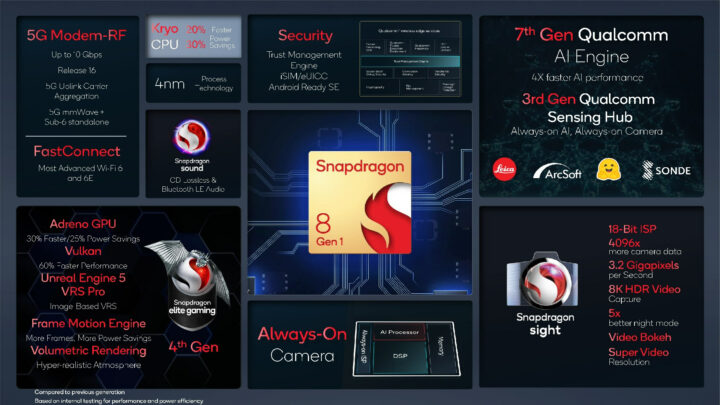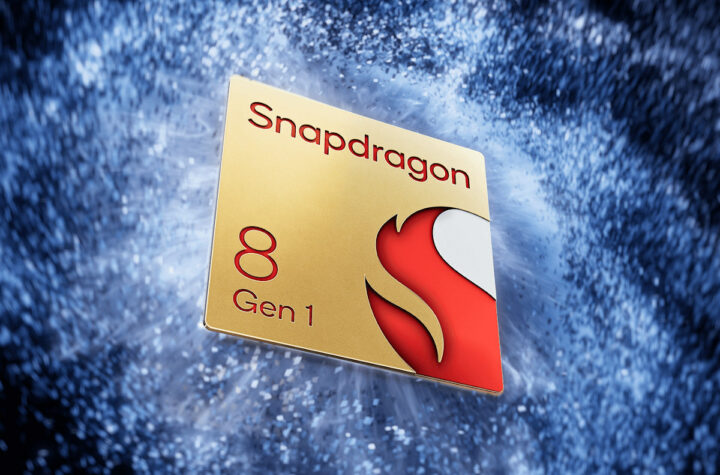A couple of weeks ago, MediaTek introduces the Dimensity 9000 5G processor with a Cortex-X2 core clocked at 3 GHz, and it was just a matter of time before Qualcomm announces its own Armv9 processor.
So here we are with the “Snapdragon 8 Gen 1 Mobile Platform” equipped with an octa-core CPU subsystem comprised of one Cortex-X2 core clocked at 3 GHz, Cortex-A710 and Cortex-A510 cores, LP-DDR5 memory, as well as an integrated Snapdragon X65 5G modem capable of 10 Gbps download speeds, and all of that manufactured with the latest 4nm Samsung process.
Snapdragon 8 Gen 1 (SM8450) specifications:
- Octa-core Kryo CPU subsystem (details courtesy of Anandtech since Qualcomm will not usually reveal this information)
- 1x Arm Cortex-X2 core @ 3.0GHz with 1024KB L2 cache
- 3x Arm Cortex-A710 cores @ 2.5GHz with 512KB L2 cache each
- 4x Arm Cortex-A510 cores @ 1.80GHz in two clusters, each with an unspecified amount of L2 cache
- 6MB L3 cache
- GPU – Unnamed next-gen Adreno GPU with Vulkan 1.1, OpenGL ES 3.2, OpenCL 2.0 FP, HDR gaming, Hardware-accelerated H.265 and VP9 decoder, etc…
- DSP – Unnamed Qualcomm Hexagon processor with
- Fused AI Accelerator – Hexagon Tensor Accelerator, Hexagon Vector eXtensions, Hexagon Scalar Accelerator
- Support for mix precision (INT8+INT16)
- Support for all precisions (INT8, INT16, FP16)
- Qualcomm Sensing Hub
- Memory – Up to 16GB LP-DDR5 @ 3200 MHz
- Storage – TBD
- Display
- On-Device – Up to 4K @ 60 Hz, or QHD+ @ 144 Hz
- External Display – Up to 4K @ 60 Hz with 10-bit color depth, Rec. 2020 color gamut, HDR10 and HDR10+
- Camera
- 3x 18-bit ISPs
- Up to 3.2 Gigapixels per second computer vision ISP (CV-ISP)
- Up to 36 MP triple camera @ 30 FPS with Zero Shutter Lag Visual Subsystem
- Up to 64+36 MP dual camera @ 30 FPS with Zero Shutter Lag
- Up to 108 MP single camera @ 30 FPS with Zero Shutter Lag
- Up to 200 Megapixel Photo Capture
- 8K HDR Video Capture @ 30 FPS
- Audio
- Qualcomm Aqstic audio codec (WCD9385)
- Qualcomm Aqstic smart speaker amplifier (WSA8835)
- Total Harmonic Distortion + Noise (THD+N), Playback: -108dB
- Qualcomm Audio and Voice Communication Suite Sensor-Assisted Positioning
- Connectivity
- Snapdragon X65 5G Modem-RF System
- 5G mmWave and sub-6 GHz, standalone (SA) and non-standalone (NSA) modes, FDD, TDD
- mmWave: 1000 MHz bandwidth, 8 carriers, 2×2 MIMO
- Sub-6 GHz: 300 MHz bandwidth, 4×4 MIMO
- Downlink up to 10 Gbps, uplink up to 3 Gbps
- Qualcomm 5G PowerSave 2.0
- Multimode support – 5G NR, LTE including CBRS, WCDMA, HSPA, TD-SCDMA, CDMA 1x, EV-DO, GSM/EDGE
- Qualcomm FastConnect 6900 System
- Tri-band WiFi: Wi-Fi 6E, Wi-Fi 6 (802.11ax), Wi-Fi 5 (802.11ac), 802.11a/b/g/n up to 3.6 Gbps
- Bluetooth 5.2 with support for LE Audio, dual Bluetooth antennas, Qualcomm aptX Voice/Lossless/Adaptive
- Location
- GNSS – GPS, Glonass, BeiDou, Galileo, QZSS, NavIC capable; dual-frequency (L1/L5)
- Sensor assisted positioning – Urban pedestrian navigation with sidewalk accuracy, global freeway lane-level vehicle navigation
- Snapdragon X65 5G Modem-RF System
- USB – USB 3.1 Type-C support
- Security
- Platform Security Foundations, Trusted Execution Environment & Services, Secure Processing Unit (SPU)
- Trust Management Engine
- Qualcomm wireless edge services (WES) and premium security features
- Qualcomm 3D Sonic Sensor and Qualcomm 3D Sonic Max (fingerprint sensor)
- Qualcomm Type-1 Hypervisor
- Wi-Fi Security: WPA3-Enterprise, WPA3- Enhanced Open, WPA3 Easy Connect, WPA3-Personal
- Compliance with the Android Ready Secure Element (SE) Alliance
- Charging – Quick Charge 5 Technology
- 4 nm process technology
Snapdragon 8 Gen 1 and Dimensity 9000 are actually pretty similar, with the exact same CPU configuration, LP-DDR5 memory, a 4nm process, and more, but the Snapdragon processor does offer a faster 5G modem (10 Gbps vs 7 Gbps), while MediaTek brings Bluetooth 5.3 and AV1 video decode. I’m not sure why neither company lists the storage interfaces.
 Qualcomm compares the performance of the Snapdragon 8 Gen 1 SoC against the previous generation Snapdragon 888+, saying the new mobile platform delivers up to 4 times faster AI performance, the CPU is 20% faster and 30% more efficient, and the GPU provides a 30% performance boost while offering 30% power savings.
Qualcomm compares the performance of the Snapdragon 8 Gen 1 SoC against the previous generation Snapdragon 888+, saying the new mobile platform delivers up to 4 times faster AI performance, the CPU is 20% faster and 30% more efficient, and the GPU provides a 30% performance boost while offering 30% power savings.
Black Shark, Honor, iQOO, Motorola, Nubia, OnePlus, OPPO, Realme, Redmi, SHARP, Sony Corporation, Vivo, Xiaomi, and ZTE will launch Snapdragon 8 Gen 1 devices as soon as this month, but most will probably only become available in Q1 2022. More details may be found in the press release and the product page.

Jean-Luc started CNX Software in 2010 as a part-time endeavor, before quitting his job as a software engineering manager, and starting to write daily news, and reviews full time later in 2011.
Support CNX Software! Donate via cryptocurrencies, become a Patron on Patreon, or purchase goods on Amazon or Aliexpress





